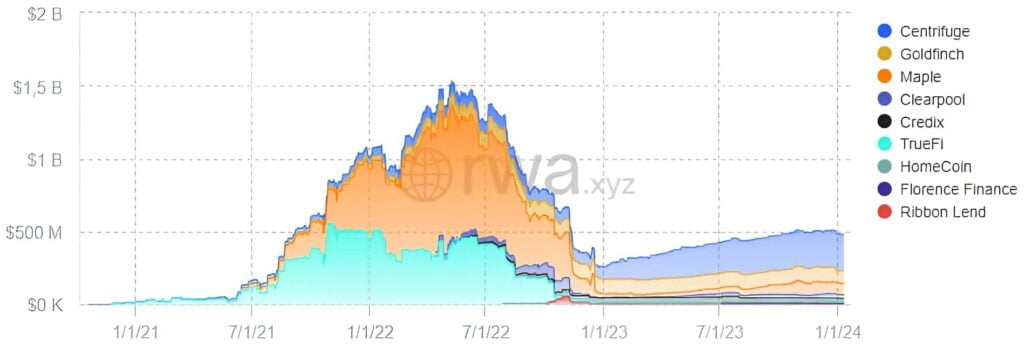Blockchain tokenized lending grows worldwide. After a period of slowdown, lending powered by blockchain technology is picking up momentum again.
Blockchain Tokenized Lending Soars. Private lending is looking to the benefits and potential of blockchain, smart contracts and stablecoins to build an alternative financial ecosystem to the traditional one, funded on-chain with benefits for participants.
Contents
Blockchain-enabled tokenized private lending
Private loans with blockchain technology are an alternative to banks to obtain financing from companies or large financial institutions. They are in charge of lending money to get profits based on the charging of interest. These loans are generally granted to non-public financial entities or companies. In other words, private loans are not traded in public markets, so they are not accessible to investors in general. This type of financing usually has stricter accreditation requirements, higher income amounts, higher interest rates and longer repayment terms. They are considered high-risk investments.
With the emergence of blockchain technology and the tokenization of Real World Assets (RWA), traditional finance has focused on how technology can optimize the efficiency of investments, such as private lending. According to figures from Morgan Stanley, the global private lending market exceeds $1.4T, but could reach $2.7 trillion by 2027, meaning a giant market opportunity for tokenization.
Tokenization of private lending is accelerating, thanks to using blockchain technology, which enables greater efficiency, accessibility, transparency and attractiveness to borrowers and investors. One of its biggest attractions is to bring decentralized finance (DeFi) to private lending, facilitating on-chain loans backed off-chain.
Benefits of tokenizing private loans with blockchain
- Increased transparency and security
- Accessibility to new markets
- More liquidity for traditionally illiquid markets.
- Automation and streamlining of processes
- Reduced barriers to entry
- Diversification
Growth in 2023
Tokenized private loans grew slightly throughout 2023, rising from $255 million to nearly $500 million at year-end. Still, this is a far cry from the all-time high reached in May 2022, when it topped $1.5 billion. But it is a sign of recovery, according to figures from RWA.xyz. Currently, total active tokenized private loans stand at $594 million. RWA.xyz has tracked $4.5 billion in tokenized loans in 1,800 funding deals.


Main protocols
different protocols that channel borrowers and lenders drive the emerging tokenized private lending sector. They offer attractive yields through stablecoins such as Tether (USDT), USDC or DAO, to form private credit structures beneficial to stakeholders. Let’s see the main protocols that facilitate the execution of tokenized loans with blockchain.
Centrifuge
It is a decentralized platform focused on financing real-world assets through a blockchain-enabled, intermediary-free process comprised of funds or pools of liquidity. Centrifuge is currently the blockchain private lending protocol with the most active loans. It exceeds $257 million in active loans within the Ethereum network, according to figures from RWA.xyz. The protocol’s total loans exceed $496 million, the third highest figure among the tracked protocols.
Maple
They are an on-chain institutional capital marketplace offering a digital asset lending services platform for accredited institutional and individual investors. Maple ranks second in active lending, with more than $152 million on the Ethereum network, and is the protocol with the most total loans, exceeding $1.8 billion, according to RWA.xyz.
Goldfinch
Goldfinch is a protocol that facilitates decentralized loans secured off-chain. That is, it eliminates the need to over-collateralize loans with cryptoassets. In this way, Goldfinch seeks to connect DeFi with traditional finance through blockchain technology, facilitating financial access in more than 28 countries worldwide through its network of borrowers. The protocol’s asset loans currently exceed $107 million, positioning it as the third largest protocol in this section. Goldfinch accumulates $113 million in total loans.
Global tokenization
Tokenized private financing powered by blockchain is applicable to numerous nations and sectors. With $200 million in active loans, the consumer sector is the leading industry for blockchain private lending. The automobile sector generates over $188 million, and financial technology, or Fintech, moves over $89 million.


Regarding countries, Africa, Asia and Latin America stand out, all channeled through the Goldfinch protocol. Nigeria (14), Kenya (12) and the Philippines (11) have the highest number of loan agreements. The average deals between these countries are between $4.8 million and $6.1 million, according to RWA.xyz. Other countries also appear in the list: India, Panama, Brazil, United States, Singapore, Thailand, Mexico, Peru, among others.

